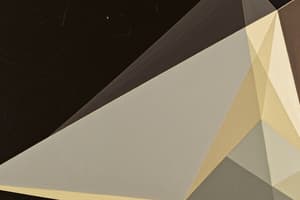Podcast
Questions and Answers
Which of the following geometric shapes have four sides? (Select all that apply)
Which of the following geometric shapes have four sides? (Select all that apply)
- Triangle
- Rectangle (correct)
- Circle
- Square (correct)
Which of the following represents a real-life application of linear equations?
Which of the following represents a real-life application of linear equations?
- Calculating the area of a circle
- Determining the cost of items based on quantity and price (correct)
- Finding the perimeter of a triangle
- Graphing a quadratic function
Flashcards are hidden until you start studying
Study Notes
Geometry
Basic Definitions
- Geometry: Branch of mathematics dealing with shapes, sizes, and properties of space.
- Point: A location with no size or dimension.
- Line: A straight one-dimensional figure extending infinitely in both directions, having no thickness.
- Plane: A flat two-dimensional surface that extends infinitely in all directions.
Types of Geometry
-
Euclidean Geometry:
- Based on postulates introduced by Euclid.
- Deals with flat surfaces and includes concepts such as points, lines, angles, and shapes.
-
Non-Euclidean Geometry:
- Includes spherical and hyperbolic geometries.
- Considers curved surfaces and the implications on parallel lines and angles.
Basic Shapes and Properties
-
Triangles:
- Types: Equilateral, Isosceles, Scalene.
- Sum of interior angles: 180 degrees.
- Area formula: ( A = \frac{1}{2} \times \text{base} \times \text{height} ).
-
Quadrilaterals:
- Types: Square, Rectangle, Parallelogram, Rhombus, Trapezoid.
- Sum of interior angles: 360 degrees.
- Area formulas vary by type (e.g., ( A = \text{length} \times \text{width} ) for rectangle).
-
Circles:
- Radius: Distance from center to any point on the circle.
- Diameter: Twice the radius.
- Circumference: ( C = 2\pi r ).
- Area: ( A = \pi r^2 ).
Key Theorems
- Pythagorean Theorem: In a right triangle, ( a^2 + b^2 = c^2 ), where ( c ) is the hypotenuse.
- Triangle Inequality Theorem: The sum of the lengths of any two sides of a triangle must be greater than the length of the third side.
Coordinate Geometry
- Uses a coordinate system to locate points.
- Distance Formula: ( d = \sqrt{(x_2 - x_1)^2 + (y_2 - y_1)^2} ).
- Midpoint Formula: ( M = \left(\frac{x_1 + x_2}{2}, \frac{y_1 + y_2}{2}\right) ).
- Slope of a Line: ( m = \frac{y_2 - y_1}{x_2 - x_1} ).
Solid Geometry
-
3D Shapes: Includes cubes, spheres, cylinders, and pyramids.
-
Volume Formulas:
- Cube: ( V = a^3 )
- Sphere: ( V = \frac{4}{3} \pi r^3 )
- Cylinder: ( V = \pi r^2 h )
-
Surface Area Formulas:
- Cube: ( SA = 6a^2 )
- Sphere: ( SA = 4\pi r^2 )
- Cylinder: ( SA = 2\pi r(h + r) )
Applications
- Architecture and engineering involve geometric principles in design and construction.
- Computer graphics utilize geometry for modeling and rendering shapes.
Important Concepts
- Congruence: Two shapes are congruent if they have the same shape and size.
- Similarity: Two shapes are similar if they have the same shape but not necessarily the same size; corresponding angles are equal, and sides are proportional.
- Transformations: Includes translation, rotation, reflection, and dilation, which alter the position or size of shapes in a consistent manner.
Basic Definitions
- Geometry focuses on the study of shapes, sizes, and spatial properties.
- A point represents a precise location without any size or dimension.
- A line is a straight figure that extends infinitely in both directions and lacks thickness.
- A plane is a flat, two-dimensional surface extending infinitely in all directions.
Types of Geometry
- Euclidean Geometry is founded on Euclid's postulates, emphasizing flat surfaces and traditional shapes like points and angles.
- Non-Euclidean Geometry encompasses spherical and hyperbolic geometries, dealing with curved surfaces and their effects on parallel lines and angles.
Basic Shapes and Properties
-
Triangles:
- Classifications include Equilateral, Isosceles, and Scalene.
- The total measure of interior angles is always 180 degrees.
- Area is calculated using the formula ( A = \frac{1}{2} \times \text{base} \times \text{height} ).
-
Quadrilaterals:
- Varieties include Square, Rectangle, Parallelogram, Rhombus, and Trapezoid.
- The sum of interior angles equals 360 degrees.
- Area calculations differ by type; for instance, rectangles use ( A = \text{length} \times \text{width} ).
-
Circles:
- The radius is the distance from the center to any point on the circle, while the diameter is twice the radius.
- Circumference is given by ( C = 2\pi r ), and area is calculated with ( A = \pi r^2 ).
Key Theorems
- Pythagorean Theorem: In a right triangle, the relation ( a^2 + b^2 = c^2 ) holds true, where ( c ) represents the hypotenuse.
- Triangle Inequality Theorem: The combined lengths of any two sides in a triangle must exceed the length of the third side.
Coordinate Geometry
- Utilizes a coordinate system for pinpointing locations of points.
- Distance Formula: The distance between two points is determined by ( d = \sqrt{(x_2 - x_1)^2 + (y_2 - y_1)^2} ).
- Midpoint Formula finds the midpoint ( M = \left(\frac{x_1 + x_2}{2}, \frac{y_1 + y_2}{2}\right) ).
- The Slope of a Line is calculated as ( m = \frac{y_2 - y_1}{x_2 - x_1} ).
Solid Geometry
-
Three-dimensional shapes include cubes, spheres, cylinders, and pyramids.
-
Volume Formulas:
- Cube: ( V = a^3 )
- Sphere: ( V = \frac{4}{3} \pi r^3 )
- Cylinder: ( V = \pi r^2 h )
-
Surface Area Formulas:
- Cube: ( SA = 6a^2 )
- Sphere: ( SA = 4\pi r^2 )
- Cylinder: ( SA = 2\pi r(h + r) )
Applications
- Geometric principles are essential in architecture and engineering for design and construction.
- Geometry plays a crucial role in computer graphics, particularly in modeling and rendering shapes.
Important Concepts
- Congruence indicates two shapes are identical in both shape and size.
- Similarity means two shapes share the same shape but can differ in size; corresponding angles are equal, and sides maintain proportional relationships.
- Transformations include translation, rotation, reflection, and dilation, which modify shapes' positions or sizes consistently.
Studying That Suits You
Use AI to generate personalized quizzes and flashcards to suit your learning preferences.




